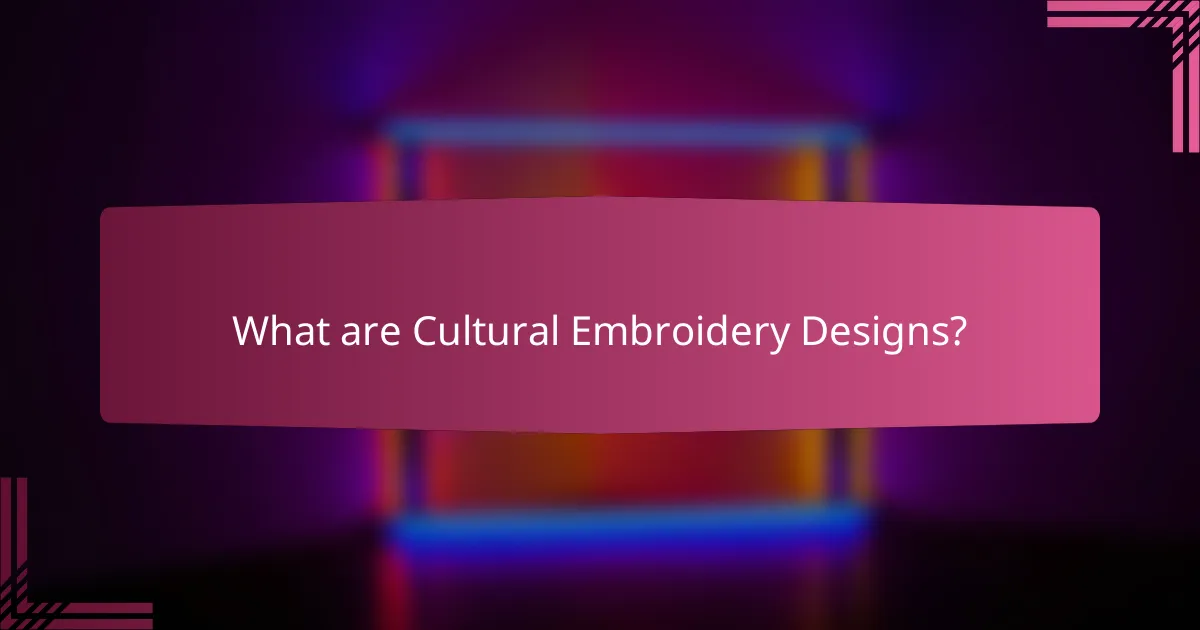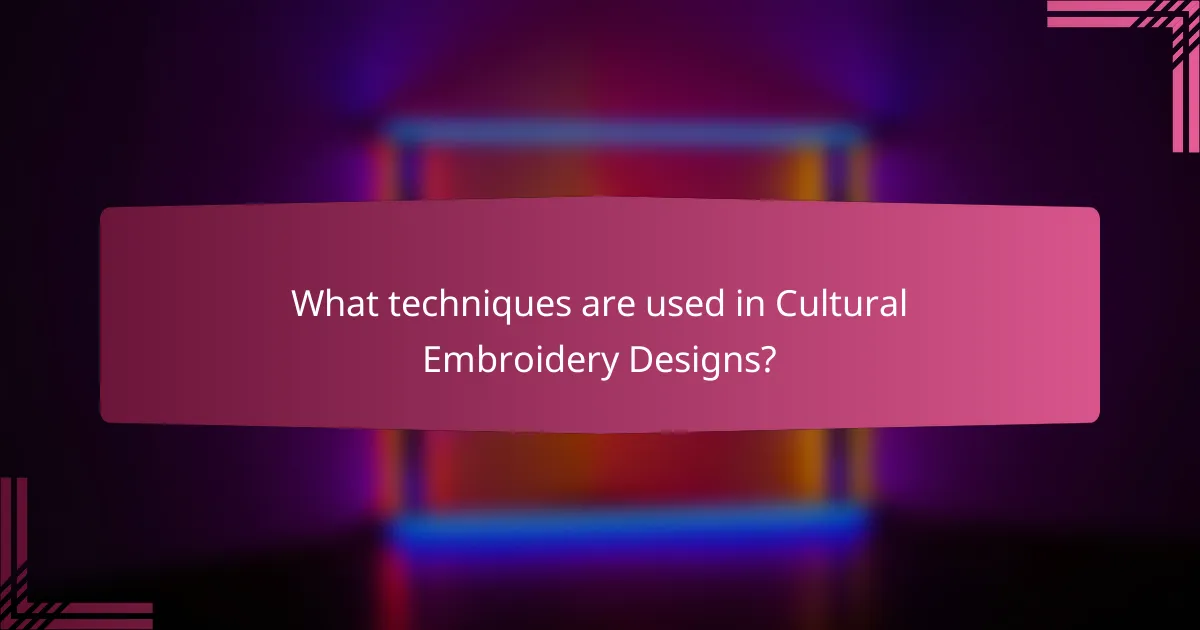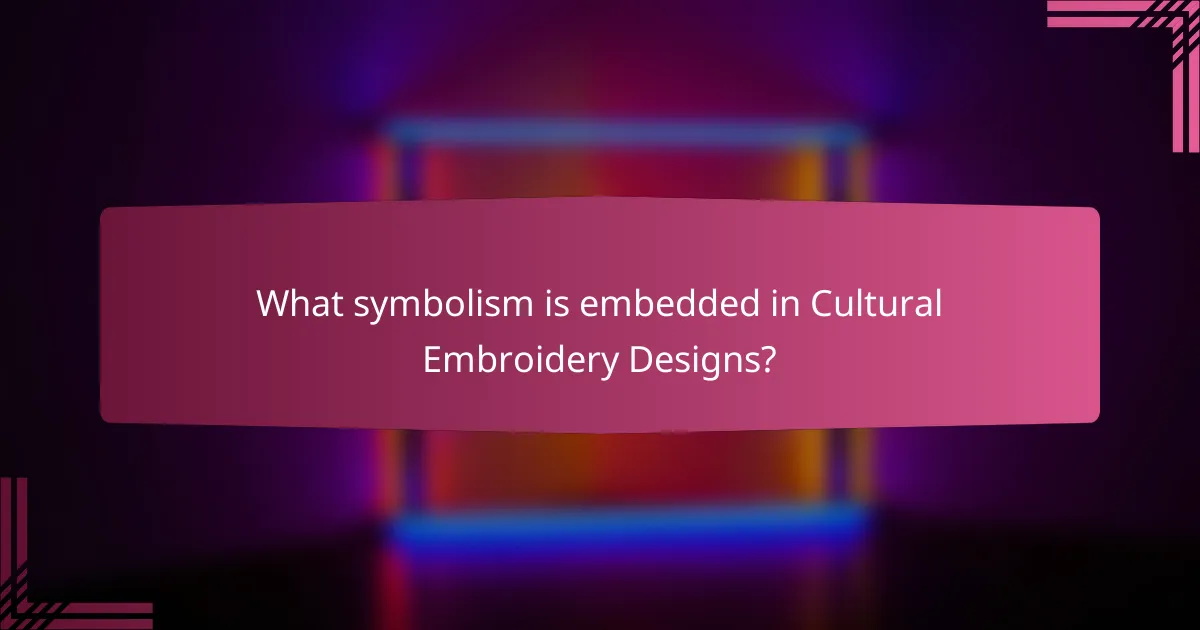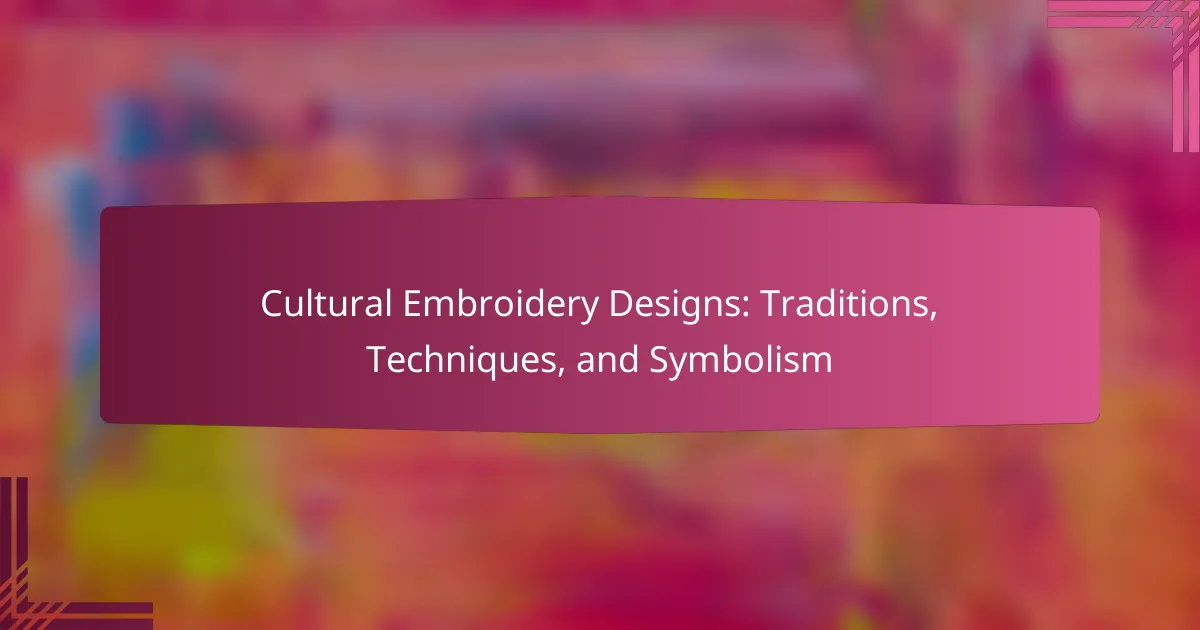
What are Cultural Embroidery Designs?
Cultural embroidery designs are ornamental patterns created through stitching techniques that reflect the heritage of specific cultures. These designs often incorporate traditional motifs, symbols, and colors that hold cultural significance. For example, Mexican embroidery features vibrant floral patterns, while Indian embroidery may include intricate paisleys and mirror work. Each design tells a story or conveys a particular meaning, often tied to historical events or local customs. Cultural embroidery serves not only as a form of artistic expression but also as a means of preserving cultural identity and traditions. The practice of cultural embroidery has been documented in various regions, showcasing its importance in community and family heritage.
How do Cultural Embroidery Designs reflect societal values?
Cultural embroidery designs reflect societal values by showcasing the beliefs, traditions, and identities of communities. These designs often incorporate symbols that represent cultural heritage and social norms. For example, specific motifs may signify fertility, prosperity, or protection. The choice of colors and patterns can also convey community status and historical narratives. In many cultures, embroidery serves as a means of storytelling, preserving history and customs for future generations. Studies have shown that the styles and techniques used in these designs are influenced by regional resources and societal changes. This connection between embroidery and societal values highlights the importance of cultural expression in maintaining community identity.
What historical events have influenced Cultural Embroidery Designs?
Cultural embroidery designs have been influenced by various historical events. The Industrial Revolution introduced mass production techniques, altering traditional hand-embroidery practices. Colonialism also played a significant role; it led to the exchange of textile techniques between cultures. Wars, such as World War I and II, impacted embroidery as women took up the craft while men were away. The rise of nationalism in the 19th century saw countries promoting their unique embroidery styles as symbols of cultural identity. Additionally, globalization has allowed for the blending of different cultural designs, creating new hybrid styles. Each of these events has shaped the evolution and significance of cultural embroidery designs across different societies.
How do different cultures interpret the concept of embroidery?
Different cultures interpret embroidery as a significant form of artistic expression and cultural identity. In many Asian cultures, such as Chinese and Indian, embroidery often symbolizes prosperity and good fortune. Traditional motifs can represent historical narratives or spiritual beliefs. In Middle Eastern cultures, intricate patterns in embroidery reflect the region’s rich history and craftsmanship. African embroidery often serves as a storytelling medium, conveying community values and heritage. In Western cultures, embroidery has evolved into a craft for personal creativity and home decor. Each cultural interpretation highlights the unique social and historical contexts that shape the practice of embroidery.
What are the main types of Cultural Embroidery Designs?
The main types of cultural embroidery designs include cross-stitch, satin stitch, and kantha. Cross-stitch is characterized by its X-shaped stitches forming a grid pattern. Satin stitch involves flat, smooth stitches covering a surface area, often used for filling shapes. Kantha, originating from South Asia, features running stitches in intricate patterns. Other notable types include crewel embroidery, which uses wool threads for detailed designs, and Sashiko, a Japanese technique emphasizing geometric patterns. Each design reflects the cultural heritage and artistic expression of its region.
What distinguishes traditional embroidery from contemporary styles?
Traditional embroidery is characterized by its adherence to historical techniques and cultural symbolism. These styles often utilize age-old methods passed down through generations. Common materials include natural fibers and dyes, emphasizing authenticity. Patterns frequently reflect cultural narratives, folklore, or religious themes. In contrast, contemporary styles embrace innovation and experimentation. They often incorporate modern materials and technology, such as synthetic fibers. Contemporary embroidery may prioritize personal expression over cultural significance. This shift allows for diverse interpretations and styles. Overall, the distinction lies in the balance between tradition and modernity.
How do regional differences shape specific embroidery techniques?
Regional differences significantly shape specific embroidery techniques by influencing styles, materials, and cultural symbolism. Each region possesses unique resources that dictate the types of threads and fabrics used. For example, coastal areas may utilize marine fibers, while mountainous regions might rely on wool.
Cultural heritage also plays a crucial role in defining patterns and motifs. Indigenous communities often incorporate symbolic designs that reflect their beliefs and history. This is evident in the intricate patterns of Native American beadwork versus the geometric designs found in Middle Eastern embroidery.
Additionally, climate affects the practicality of certain techniques. Warmer regions may favor lighter, breathable fabrics and simpler stitches, while colder climates might embrace layered, more complex designs for warmth.
Historical trade routes further contribute to the diversity of embroidery techniques. The Silk Road facilitated the exchange of ideas and materials, leading to hybrid styles that blend multiple cultural influences.
Overall, regional differences create a rich tapestry of embroidery techniques that are deeply rooted in local traditions and environmental factors.

What techniques are used in Cultural Embroidery Designs?
Cultural embroidery designs utilize various techniques to create intricate patterns and symbols. Common techniques include satin stitch, which fills shapes with smooth, flat stitches. Another technique is chain stitch, known for its looping design that resembles a chain. Cross-stitch is also popular, involving X-shaped stitches that form images. Additionally, appliqué involves sewing fabric pieces onto a base fabric to create designs. Embellishments like beads and sequins enhance the visual appeal of these designs. Techniques often vary by culture, reflecting unique traditions and meanings. For example, traditional Indian embroidery includes techniques like Zardozi, which uses metallic threads for opulence.
How do artisans choose their embroidery techniques?
Artisans choose their embroidery techniques based on cultural traditions and personal preferences. They often consider the historical significance of specific techniques within their community. The choice may also depend on the intended use of the embroidered piece, such as clothing or decorative items. Additionally, artisans assess the materials available to them, which can influence technique selection. Skill level plays a crucial role, as some techniques require more advanced abilities. Artisans may also draw inspiration from regional styles or patterns. The choice of technique can reflect personal expression or storytelling. Ultimately, these factors combine to guide artisans in their embroidery technique selection.
What tools and materials are essential for cultural embroidery?
Essential tools and materials for cultural embroidery include embroidery needles, threads, and fabric. Embroidery needles are specifically designed for hand stitching and come in various sizes. Threads vary in thickness and material, including cotton, silk, and wool. Fabric choices often include cotton, linen, or silk, depending on the cultural tradition. Additionally, embroidery hoops are used to keep fabric taut while working. Scissors are essential for cutting threads and fabric. Marking tools help in transferring designs onto the fabric. Each tool and material contributes to the unique characteristics of cultural embroidery.
How do various stitching methods affect the final design?
Various stitching methods significantly influence the final design of embroidery. Different techniques create distinct textures and visual effects. For instance, satin stitch produces a smooth, shiny finish, enhancing the vibrancy of colors. In contrast, backstitch offers a more defined outline, which can add depth to intricate patterns.
Additionally, techniques like cross-stitch allow for pixelated designs, making them suitable for detailed imagery. The choice of thread thickness and type also impacts the overall appearance. For example, using metallic threads can add a luxurious sheen, while cotton threads provide a matte finish.
Moreover, stitching methods can alter the durability and longevity of the design. Techniques that involve tighter stitches can create a more resilient fabric, whereas looser methods may lead to fraying over time. Historical evidence shows that traditional practices often dictated specific stitching methods to convey cultural significance in designs.
In summary, the selection of stitching methods is crucial in determining the aesthetic and functional qualities of the final embroidery design.
What role does color play in Cultural Embroidery Designs?
Color plays a crucial role in cultural embroidery designs by conveying meaning and symbolism. Different colors represent specific cultural beliefs and values. For instance, red often symbolizes luck and prosperity in many Asian cultures. In contrast, blue might represent tranquility or [censured] in various traditions. The choice of color can also indicate social status or regional identity. Historical context shows that color preferences vary significantly across cultures, influencing design choices. For example, indigenous Mexican embroidery often features vibrant colors reflecting local flora and fauna. This connection to nature enhances the cultural narrative embedded in the designs. Overall, color is not just aesthetic; it is integral to the storytelling aspect of cultural embroidery.
What meanings are associated with different colors in embroidery?
Different colors in embroidery carry specific meanings and symbolism. Red often represents love, passion, and courage. Blue symbolizes tranquility, calmness, and wisdom. Yellow is associated with joy, happiness, and warmth. Green signifies nature, fertility, and growth. Black can denote mourning, but also elegance and sophistication. White typically represents purity, peace, and innocence. Each color’s meaning may vary by culture and context, reflecting diverse traditions in embroidery. For example, in Chinese culture, red is favored for celebrations, while in Western contexts, black is often used in memorial pieces.
How do color choices vary across cultures?
Color choices vary significantly across cultures. Different cultures associate specific colors with unique meanings and emotions. For instance, white symbolizes purity in Western cultures but represents mourning in some Eastern cultures. Red is often linked to luck and prosperity in China, while it can signify danger in other contexts. In India, colors like yellow and orange are associated with celebration and [censured]. Conversely, in some African cultures, colors can represent social status or tribal affiliation. These cultural associations influence various aspects, including fashion, art, and design, particularly in traditional embroidery. Understanding these variations is crucial for appreciating cultural significance in design.

What symbolism is embedded in Cultural Embroidery Designs?
Cultural embroidery designs often symbolize heritage, identity, and beliefs. Each stitch and pattern reflects the history and values of a community. For example, floral motifs can represent fertility and growth in many cultures. Geometric patterns may signify harmony and balance. Specific colors also hold meaning; red often symbolizes strength, while blue can represent peace. The use of animals in designs frequently conveys protection or guidance. These symbols can vary significantly across different cultures, showcasing unique narratives and traditions. Historical context reinforces the importance of these symbols, as they have been passed down through generations.
How do motifs and patterns convey cultural stories?
Motifs and patterns convey cultural stories by symbolizing beliefs, values, and historical narratives. Each design element often represents specific cultural meanings. For example, floral motifs can signify fertility and growth in many cultures. Geometric patterns may reflect social order or cosmological beliefs. The colors used in these designs also carry significance, such as red symbolizing luck in Chinese culture. Historical context enhances understanding, as traditional patterns can be linked to specific events or eras. By studying these motifs, one gains insights into the cultural identity and heritage of a community.
What are common symbols found in different cultural embroidery?
Common symbols found in different cultural embroidery include flowers, animals, and geometric shapes. Flowers often represent beauty, growth, and fertility. Animals symbolize strength, protection, and various cultural beliefs. Geometric shapes convey balance, harmony, and order.
For instance, in Mexican embroidery, the use of flowers signifies life and celebration. In Indian embroidery, peacocks are prevalent and symbolize grace and beauty. African embroidery frequently includes geometric patterns that reflect community and identity. These symbols vary significantly across cultures, each carrying unique meanings and stories.
How do personal experiences influence the symbolism in designs?
Personal experiences significantly influence the symbolism in designs. Designers often draw from their own backgrounds, emotions, and memories. These experiences shape their creative choices, leading to unique symbols. For instance, a designer might incorporate motifs that reflect their cultural heritage. This personal connection can imbue designs with deeper meaning. Research shows that personal narratives enhance the emotional impact of visual art. A study by T. T. H. Ho and R. J. A. R. R. Kwan (2019) highlights how individual experiences translate into creative expression. Such influences make designs resonate more with audiences.
What significance do Cultural Embroidery Designs hold today?
Cultural embroidery designs hold significant value today as they preserve heritage and identity. These designs reflect the history and traditions of specific communities. They serve as a medium for storytelling and cultural expression. Many contemporary artisans use these techniques to revive interest in traditional crafts. Cultural embroidery also promotes sustainability through the use of local materials. Additionally, these designs contribute to the global art scene, enhancing cross-cultural appreciation. According to a report by UNESCO, traditional crafts like embroidery are essential for cultural diversity. Thus, cultural embroidery designs are vital for maintaining cultural continuity and fostering community pride.
How are traditional designs being preserved in modern contexts?
Traditional designs are being preserved in modern contexts through various methods. Artisans incorporate traditional motifs into contemporary fashion. This fusion allows cultural expressions to remain relevant. Educational programs teach traditional techniques to new generations. Workshops and online courses facilitate skill transfer. Digital platforms showcase traditional designs to a global audience. Collaborations between designers and artisans promote cultural heritage. Community initiatives support local craftspeople in maintaining traditions. These efforts ensure that traditional designs continue to thrive in a modern setting.
What impact does cultural embroidery have on identity and community?
Cultural embroidery significantly impacts identity and community by serving as a medium for expression and connection. It reflects cultural heritage and traditions, allowing individuals to showcase their roots. Each stitch can represent specific narratives, symbols, and values unique to a culture. This practice fosters a sense of belonging among community members. It often involves collective participation, strengthening social bonds. For instance, in many cultures, embroidery workshops serve as communal spaces for learning and sharing stories. The visual language of embroidery can also promote cultural pride. Studies show that engaging in traditional crafts enhances community cohesion and identity reinforcement.
What tips can help beginners start with Cultural Embroidery Designs?
Begin by selecting a specific cultural embroidery style to focus on. Research the history and significance of that style. Gather essential materials such as fabric, threads, and needles. Start with simple patterns to build confidence and skills. Practice basic stitches like backstitch and satin stitch. Utilize online tutorials and resources for guidance. Join local or online embroidery groups for support and inspiration. Document your progress to track improvement and techniques learned.
What resources are available for learning embroidery techniques?
Resources available for learning embroidery techniques include online courses, books, and community workshops. Online platforms like Craftsy and Skillshare offer structured courses for various skill levels. Books such as “Embroidery: A Handbook for Beginners” provide detailed instructions and illustrations. Community workshops often hosted by local craft stores or community centers allow hands-on learning. Additionally, YouTube has numerous tutorials that cover specific techniques and styles. These resources collectively help learners develop their skills and understanding of embroidery.
How can one choose the right materials for cultural embroidery projects?
To choose the right materials for cultural embroidery projects, consider the fabric, thread, and tools. The fabric should reflect the cultural significance of the project. Common choices include cotton, silk, or linen, each offering different textures and durability. The thread should match the fabric in weight and color. Natural fibers like cotton or silk are often preferred for their authenticity. Tools such as needles and hoops should be compatible with the chosen fabric and thread. Researching traditional methods enhances material selection. For example, certain cultures favor specific colors or patterns that hold symbolic meaning. Understanding these aspects ensures the project honors its cultural roots.
Cultural embroidery designs are ornamental patterns created through stitching techniques that reflect the heritage of specific cultures, incorporating traditional motifs and colors with significant meanings. The article explores how these designs convey societal values, historical influences, and cultural interpretations, detailing various types and techniques used in embroidery. It also discusses the role of color, symbolism, and personal experiences in shaping designs, as well as the significance of cultural embroidery in contemporary society. Additionally, the article provides tips for beginners and resources for learning about cultural embroidery techniques.
